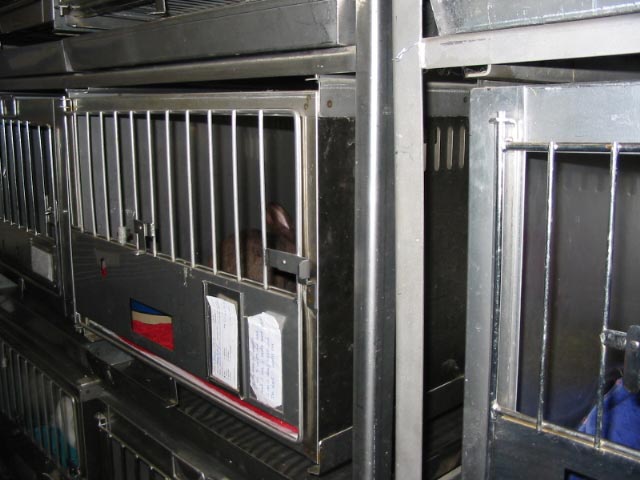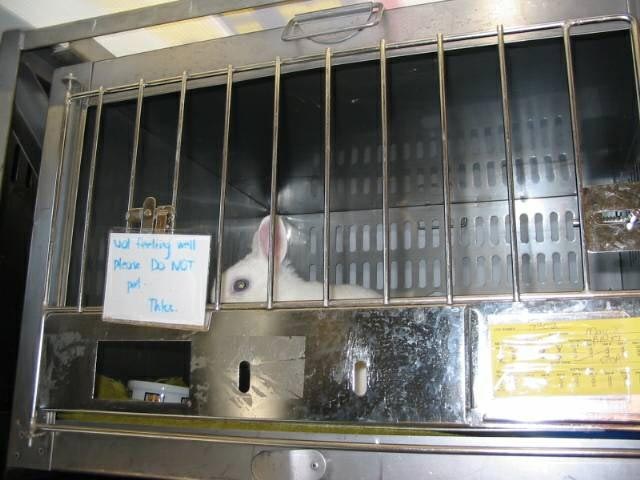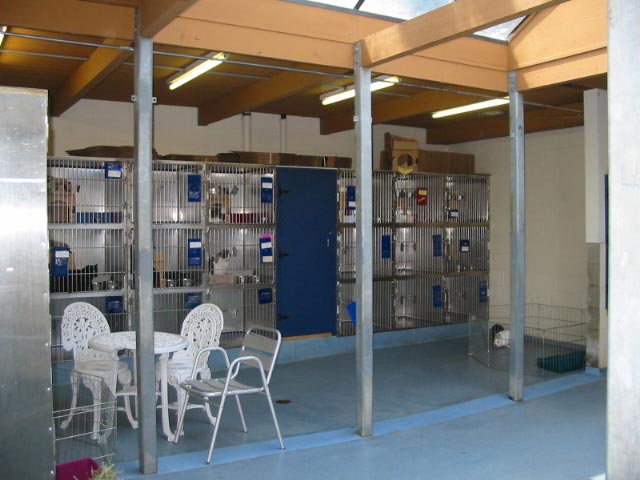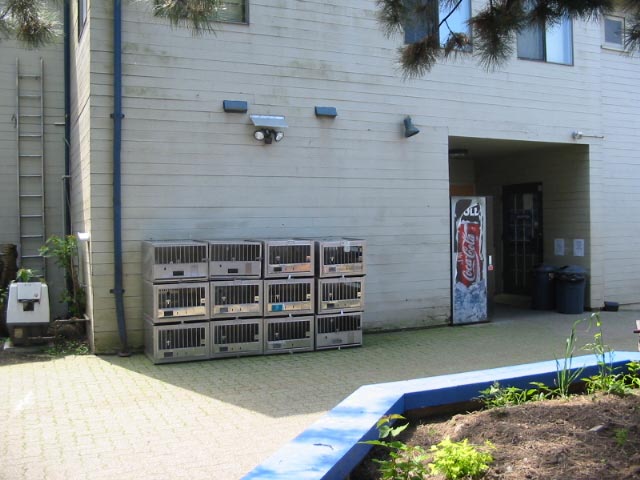Rabbits at the Vancouver SPCA
July 28 2005
Here are the SPCA's oft-repeated "Five Freedoms". They look good in the media and on the BC SPCA website, but the SPCA itself seldom provides all the Five Freedoms for the animals it keeps. Here they are right from the SPCA's web site. We dispute that these rabbits at the Vancouver SPCA have freedom from discomfort and distress, and especially to have the freedom to express behaviours that promote well-being. When one of the SPCA's head officers was queried about the distress caused to the rabbits by being kept for as long as two weeks without being allowed out to stretch their legs and indulge in some "freedom", his answer was a search for a justification for the sizes of the cages, which he found by apparently quoting Humane Society of the U.S. figures. Those figures can't be confirmed in a search of the HSUS site.
1. Freedom from hunger and thirst
2. Freedom from discomfort
3. Freedom from pain, injury or disease
4. Freedom from distress
5. Freedom to express behaviours that promote well-being
Rabbit experts and rescuers describe the symptoms of distress in rabbits that are kept in close confinement for long: "While a cage may be used as a "home base" for a house rabbit the failure to provide an opportunity to exercise leads to the possibility of the animal developing both physical and behavioral problems. Various disorders may include stress, aggression, obesity, listlessness, bone density thinning and poor muscle tone, sore hocks, and runny eyes. although these cages are used as a temporary "home", this does not preclude the fact that exercise is an essential component to overall health."
In the fall of 2004 the Vancouver SPCA was the recipient of 12 lab cages from UBC. The inside measurements of these cages are roughly 5.2 cu ft (25"l x 24"w x 15"h) and are being used as primary "housing" for rabbits.


However, a number of references indicate that this size enclosure does not meet minimum recommended criterion for humane occupancy.
The House Rabbit Society (San Diego Chapter) suggests that for average size breeds (5-10 lbs.) a cage no smaller than 10.5 cu ft. The North Georgia chapter advises as a minimum cage requirement 11.25 cu ft. A quote from the US Department of Agriculture, 1991 states that a cage should always be "sufficiently sizes to allow normal postural adjustments with freedom of movement." An excerpt from "Comfortable Quarters for Rabbits in Research Institutions" Animal Care Centre, UBC further adds that the space should allow for "three hops in one direction" as well as to permit them to "sit upright on their hind feet without their ears touching the top" of the cage.
While a cage may be used as a "home base" for a house rabbit the failure to provide an opportunity to exercise leads to the possibility of the animal developing both physical and behavioral problems. Various disorders may include stress, aggression, obesity, listlessness, bone density thinning and poor muscle tone, sore hocks, and runny eyes.
Although these cages are used as a temporary "home" this does not preclude the fact that exercise is an essential component to overall health.
The antiquated practice of restricting freedom and confining animals is not one that speaks to the "prevention of cruelty." Quite the contrary.
Carmina Gooch, North Vancouver
I have written the BC SPCA on a number of occasions about the welfare of rabbits. Most recently was regarding the use of these lab cages in which the rabbits are kept. I was informed that the sizes meet the minimum requirements set out by the Humane Society of the United States. As my research did not find any specifics. I asked what they were but did not receive a reply. I did find the American SPCA website and they suggest 16 cu ft and the BC SPCA Rabbit Care fact sheet suggests 24 cu ft.
Regardless of whether these cages are being used as a temporary base the SPCA ought to be a voice in advancing the standards of animal care.
Terry Roberge, North Vancouver
I would say the cages are contrary to the SPCA-- prevention of cruelty to animals. The small area gives the impression that your organization condones the keeping of rabbits this way. What I see is that they are trapped and inhibited from freely exercising or moving about.
Maureen Collins, North Vancouver

While they may not be "suffering unduly" this does not justify an organization that "speaks for the animals" using this type of "housing"
Posted By: Carmina Gooch,
Rabbit Rescuer and Advocate
Date:
Saturday, 30 July 2005,
at 10:03 p.m.
The white tag on the cage says: Not feeling well. Please DO NOT pet. Thanks
We are well aware that several different sizes of cages are used to accommodate the rabbits but the lab cages are the ones of most concern. They allow for minimal movement only and as these rabbits are confined for indefinite periods of times this can lead to stress and illness. While they may not be "suffering unduly" this does not justify an organization that is supposed to "speak for the animals" using this type of "housing".
Nor should it be the
volunteers who provide the hay and fresh greens, at their own expense.
The SPCA has to direct more resources towards the welfare and advocacy of
rabbits.
Carmina Gooch
North Vancouver
###
Comment: The SPCA knew the lab cages were inadequate before they were installed, and have been an issue of concern since they were introduced. Given the SPCA's budget and donations one would think money could be allocated for suitable housing. And as an an welfare organization, one would think the rabbits would be provided with an area for exercise.
From
website of Susan A. Brown, DVM
http://www.hrschicago.org/dietcarefr.html
"ENVIRONMENT"
Cage
House rabbits should never be kept completely confined to a cage. Exercise is vital for the health of the rabbit.All too often we hear well meaning, but poorly informed, people describe rabbits as easy to keep because “they can be caged and don’t take up much space!”This idea has led to many rabbits being caged most of their lives with the distinct possibility of developing both physical and behavioral disorders. They are designed to run and jump and move about a large area.
To confine a rabbit to a cage exclusively to a cage can cause several problems:
-
Obesity – caused most often by a diet too high in calories coupled with a lack of exercise
-
Pododermatitis – Inflammation of the feet caused by sitting in a damp or dirty environment
-
Poor bone density - Rabbits that are continually confined to a small cage can exhibit marked thinning of the bones which may lead to more easily broken bones when handling
-
Poor muscle tone - If the rabbit can’t exercise, the muscles, including the heart, will be underdeveloped and weak
-
Gastrointestinal and urinary function - A rabbit that sits all day in the cage with little exercise can develop abnormal elimination habits
-
Behavioral problems - Continually caged rabbits can exhibit a wide range of abnormal behaviors including lethargy, aggression, continual chewing of the cage bars, chewing fur (obsessive grooming), and destruction of the entire contents of the cage.
A cage can be used as a “home base” for part of the day or it can be open all the time.
Exercise Area
As mentioned, it is vital to the health of your pet to provide an exercise area where your pet can roam for a few hours every day. The easiest way to accomplish this is to use exercise fencing panels sold for dogs. These can be found at most pet stores. Buy fencing that is at least three feet high for small and medium rabbits and four feet high for giant breeds."
Vancouver SPCA improves conditions for rabbits
Posted By: Carmina Gooch
Date:
Wednesday, 31 May 2006,
at 6:27 a.m.
On the mural outside of the Vancouver SPCA it says "compassion & caring since 1898." Inside, rabbits were incarcerated in tiny lab cages, sometimes for months on end. Since being installed in the fall of 2004 there were numerous complaints directed at the SPCA for making such an ill-considered decision. How could this possibly be defined as animal welfare or serve as a humane model, worthy of imitation?
Well, at long last those twelve cages have now been taken out and replaced with twelve more spacious ones. In addition, the cat room recently underwent some renovations and with a wall being removed this allows for more floor space. On today's visit it was encouraging to note that two small exercise pens were set up for the rabbits.
Such a simple change can make a world of difference.



Comment: November 2008 The Vancouver SPCA is planning to replace the existing rabbit cages in the next few months.
Comment: January 2009 The cages haven't been replaced but management made the decision to substantially reduce the number of rabbits at the facility citing it's "too confusing" to the public when they see large numbers. Funny how the same rule doesn't apply to dogs or cats.
Comment: April 2009 The SPCA has never given the same regard to rabbits as it does to dogs and cats. The cages haven't been replaced with more suitable housing, and if it wasn't for the volunteers, the rabbits would be all but ignored.
Comment: May 20, 2009 There have been a number of concerns from the volunteers who dedicate their time to the rabbits at the Vancouver SPCA. This is nothing new, and at the end of May most are leaving. The rabbits under their care are being transferred out of the SPCA and into rescue until they can be adopted. Head Office has announced there will be an imminent staff reduction, and that the Society has no money for small animals and that its efforts have to be concentrated on animals that adopt. The Burnaby branch will no longer be accepting rabbits. The BC SPCA has never been a significant voice for rabbits, and it's only because of public pressure that the organization has done the "speaking" it has. Unfortunately, there were no voices to "speak" for the assortment of rodents that were destroyed recently. The Rabbit Advocacy Group of BC has once again contacted the SPCA regarding its lack of rabbit welfare and reforms that are in keeping with the modern and ethical animal rights movement.